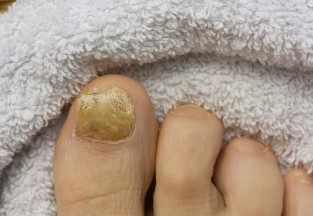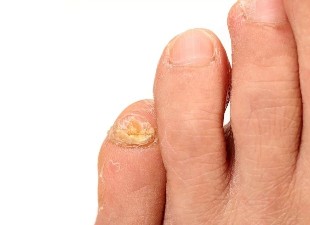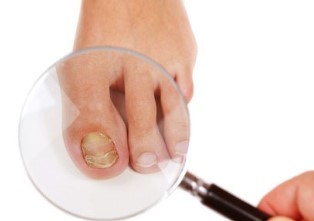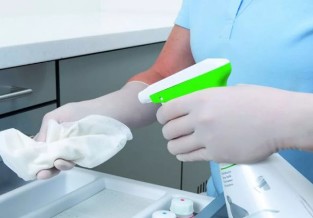There is hardly a person who has never heard of such a pathology, such as nail fungus. Anyone unfamiliar with the diagnosis, the advertising of pharmaceutical drugs, and the one I found out about the disease first-hand, leaving the dermatologist's office, or by the diagnosis itself.

Definition of the
The medical term onychomycosis (lat. onychomycosis is a Latin word and it means a nail fungus, and the means of the infectious diseases of a fungal nature. This is the largest in the world, the defeat of the nail plate and the adjacent soft tissues, according to the statistics of the world health organization (who), the athlete's foot affects about 27% of the people, and this figure is almost twice the number of fungal infections of the nails of the fingers.
Types of fungal infections of the nails
Onychomycosis is usually classified according to the appearance of the affected areas. As a symptom which done what looks like a fungus on the nails, it is differentialsa of three types, depending on the type of clinical manifestations:
- atrophic, or onycholitic in which the nail plate is significantly affected, to the point of striking out from the nail bed;
- hypertrophic forms, which have lost their natural shine of the nail changes its color (white or, on the contrary, in the dark) and the structure (material thick) with the advent of a variety of different types of deformations and even breaks of the edges;
- normotroficheskie – types, which are characterized by the lowest extent of the damage, in which the nail plate is not thickened, while the rest is shiny and smooth, but the outside transformed by the appearance of spots, stripes, and other noticeable changes in its natural transparency and colour.
There is still another classification, in which the nail fungus can be divided into types depending on the type of injury:
- in total, in which the pathogenic process that covers the entire nail plate;
- the distal form of the lesions only on the free edge of the nail, acting on the finger pad;
- proximal, which destroys the edge of the plate, leaving the nail shaft (as opposed to the free edge of the nail!);
- the lateral shape of the lesions affecting the lateral side of the nail plate.

It looks like a pathology
Common among the populations of fungal nail diseases have a similarity to other dermatological diseases of a fungal nature. Depending on the stage of the disease, the nails begin to look unhealthy, because it loses the natural Shine and transparency.
From the smooth and flat, so that they can become thick and deformed, and covered with a different color (usually white or dirty yellow) tinge. The soft tissue can be destroyed by a parasite keratin layer is also involved in the inflammatory response, swelling.
If you look at the picture of the destruction of the nail plate from the point of view of the dynamics of the disease, it can be divided into three successive stages:
- In the first phase, almost no sign, except for light tarnish, spots, or stripes on the record.
- T.n heavy-stage, fast-paced in the beginning, all of the symptoms of onychomycosis is becoming apparent.
- An advanced phase – that is the ultimate degeneration of the nails, it can be complemented with the smell of the decaying tissue.
The symptoms of fungus in the nails
The signs and symptoms of athlete's foot fit in the timeline of the development of the pathogenic process, the speed of which depends on the type of pathogen and the individual characteristics of the health status of the person.
So how do you establish a nail fungus before you visit the dermatologist's office? Look closely at the specific symptoms that accompany a yeast infection of the nail plates on my fingers:
- First of all, the nail plate loses its shiny luster, to become dull and rough.
- Then, the transparent and pink, the nails change color, become whitish, gray, or a dirty yellow.
- The plate thickness is increased.
- On the surface of the body, the defects appear in the form of stripes, waves, bumps, curves, and so on.
- The nail appears frail it will start to exfoliate and crumble.
- His fingers due to a rise in the inflammatory process starts to be transmitted to the next morning.

In the end, totally destroyed the exposed nail onycholysis, or flaking, exposing the pringtime in bed.
Causes of onychomycosis
Outside, it is one of the manifestations of the mycosis, which has been at a loss, and in this case, the nail-plate micro-organisms-dermatophytes of one (or more!) of the three types:
- Microsporum (species canis);
- Trichophyton (rubrum varieties – 90% of all fungal infections mentagrophytes, interdigitale, and tonsurans is the most common causative agents of fungal infections;
- Epidermophyton (floccosum species).
Representatives of all three genera, United by the collective name of the "nail fungus", when ingested, populate (i.e., localized) keratinized derivative of the epidermis of the skin:
- the nail;
- hair.
The reason for the selectivity of a housing for a micro-parasites lies in their power: all of the members as a source of energy to be used by the fibrillar protein keratin, thereby destroying your nails, and hair.
The methods of infection.
All types of the disease-causing pathogens transmitted by the contact method:
- physical contact from an infected person to a healthy;
- the use of the things that have come into contact with the affected parts of the body (shoes, personal items, etc.).
Contact with the nail or on the skin, which has become the habitat of the parasites, which enables them to live as representatives of the fungus to get on the healthy parts of the body.
At the same time that the causative agent of onychomycosis has been able to carry out the infiltration in the human tissue requires that the terms and conditions, such as:
- the damage to the integrity of the skin (dermatitis, diaper rash, vascular, and diseases of the skin, abrasions, wounds, etc.);
- a weakened immune system.
- the presence of concomitant diseases (genodermatosis, and hemolytic disease, immune, and endocrine disorders);
- receiving cytostatic and hormonal preparations and antibiotics.

In connection with the foregoing, the penetration of the parasite into the body of a healthy person is not, in all cases, without exception, gives rise to the clinical manifestations of the disease, or only a very weakly marked forms of the pathology.
Due to certain specific terms and conditions, including immune protection, the person shall be an external sound, it becomes a carrier of the parasite, infecting other people.
How to recognize the disease
Due to the similarity of the mycotic lesions with mechanical symptoms, deformities, and other pathologies of the nail plate, and on the basis of a clinical diagnosis, it is not just the external signs — what is nail fungus — and more and more and in addition to their outcomes on the micro-case studies.
Laboratory analysis is used the pieces of lands affected nails, for the production of a scraping for fungus, nail with special tools.
The specific form of the parasite is found on the side of two of the most convenient research
- the culture of the placing of the biological sample of a diseased tissue in a special nutrient medium;
- the molecular-biological method, or the t's.n. polymerase chain reaction (PCR).
A more accurate DNA diagnosis is still not common.
In answer to the question: "how do you recognize nail fungus-home", experienced dermatologists will advise you to consult with a specialist in the implementation of the full-scale and in the necessary cases, and differential diagnosis.
What is the danger of nail fungus
Simple nail fungus symptoms, there are, although uncomfortable, but in the traditional of fungal infections: stratification of the nails, and pain, and so on.
However, in some cases, mycotic, may be incorporated into, for example, a bacterial infection, or the disease may begin acutely, with the appearance of blisters, ulcers, weeping areas of the surrounding soft tissues.
Sometimes, a medical treatment, over the course of a long-term outpatient (more than 16 weeks!), not ineffective, and the disease is fairly advanced.
How dangerous is nail fungus a long-term cure? In the inflammatory process and the involved bodies and their systems, and they may need immediate hospitalization of the patient.
Methods for the treatment of fungus of the nails
In the early stages of the disease, conventional medicine uses conservative methods, through the designation of a medical treatment.
An anti-mycotic drug, in order to destroy the fungus underneath the nail, it also contain substances able to inhibit the activity of their respective cliches. To achieve an effective therapy, it can be used in various pharmacological forms, and sometimes complex assign:
- pills — for taking orally (through the gastrointestinal tract, usually the water is for drinking), carried out in the absence of the effect of the topical medication;
- ointments, pastes and gels for local, topical use of by applying a drug directly to the affected part of the parasite body;
- aerosols;
- the solution (resorcinol, boric acid, brilliant green, etc.). and the suspension of the application tool-soaked wipes for the affected area, or the use of the drug in the form of therapeutic baths.
The drugs are normally used two times a day until resolution of clinical signs. In the event of a significant keratosis in order to facilitate the penetration of the dosage form in the keratin formation is carried out by its partial detachment. If the signs of nail fungus include the addition of a secondary bacterial infection, the patient is recommended that a combination of antibiotics.
Important! If you resort to systemic Anti-mycotic is to be followed, it is possible that a functional disorder must have produced a biochemical study of the liver (the analysis of blood serum for the presence of bilirubin, in the presence of the enzyme aspartate aminotransferase, gamma-glutamyltransferase, and so on.
If the patient is, at present, for example, the nail fungus on her thumb, all of a sudden appear in acute inflammation and/or severe scratching, the use of the funds:
- antihistaminicas (swelling and inflammation);
- desensitize (decrease sensitivity).

Treatment through the use of pharmacological agents, as a rule, is safe and lasts for a long period of time, not less than three months!
This is the duration of the treatment was due to the introduction of the pathogen into the structure of the nail, it takes a while for it to continue, in line with the gradual circumcision affected areas. If the disease is in the stage in which medical treatment fails to give positive results (total and a form) or the patient – the person of the old, the use of radical methods, the surgical removal of the parasites have been destroyed on the nail.
To prevent
The best treatment is a preventive action, because prevention is much easier than the first to settle on the fungus on the nail and then get rid of it. A good way to help prevent infection, it is committed to the strict adherence to the rules of personal hygiene, especially in public places, the imminent danger of the potential for contact with native speakers of the mycosis, as well as the prevention of:
- foremost, the exceptional, the abnormal dryness of the skin, abrasions, minor wounds, and hyperhidrosis, and, in the case of their occurrence – prompt treatment with, for example, aluminium hydrochloride 15%, with ditilinom glycol of 1% on the excessive sweating of the feet;
- secondary disinfection special solutions of the objects in contact with the source of athlete's foot (shoes, towels, etc.).
It has the correct information of what it is up to the nail fungus, it is realistic to protect yourself and your family from intrusion, and, in the case of illness, timely and appropriate methods of treatment, can speed up the healing process.





























